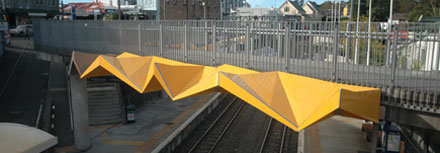Electric trains a ‘bolt from the blue’ opportunity for Pollen Integrated

Normally, seeing a giant lightning bolt above Auckland’s new electric train network would be rather frightening. But what if this lightning bolt was there to protect you?
Pollen Integrated, a “landscape architecture consultancy with a focus on urban product design” has created a new type of safety screen combining design and functionality.
Part of KiwiRail’s recent transition to electric trains involves putting up safety screen to make sure the public doesn’t get electrocuted by accidentally coming into contact with the wires.
Overseas, the job is mostly done using big, ugly nets, but in Auckland the council had other ideas, Ellis says. Instead of going for something cheap and nasty, Auckland Council decided to opt for a rather more aesthetically pleasing solution.

“The council wanted the screens to have an artistic look and add to the overall look of the city”, says Ellis. For that reason, they gave him quite a lot of creative control, he says.
So far around 45 bridges in Auckland have been fitted with the safety screens, with most bridges having two screens, one for each side.
Ellis has also exported a version of the modular screen system to Australia and is looking for more cities where the horizontal safety screens can be applied, possibly as far away as the UK.
Pollen worked alongside structural engineers Aecom, taking charge of the design side of things, while they took care of the specification.
“Working with Aecom was hugely collaborative… having an engineer open to creative solutions is a rare thing.” He says the system is unique in the world.
“Traditionally you would just cage the lines off so no one has access to them. A 1950s zoo aesthetic.
“Ours is open, plus it has a meaning as part of an urban landscape.”
These are two very different approaches. As Ellis puts it: “Essentially, we are comparing urban product design to a purely engineered solution.”
Ellis says he wanted to design something that was both a symbol for the new train network, but also a visual warning of the hazards posed by electrification.
“The lightning bolt form communicates the real danger that is present, further emphasised by the safety yellow we have chosen. “This is essentially a hardcore engineering solution meeting a interpretive design project.”
Ellis also sees an opportunity for the safety screens to become unique art installations in the future. “I think making them artworks would really enrich their value,” he says.
He sees most opportunity around the vertical screens that were made for some bridges and walkways, but also likes the idea of getting a few extra horizontal screens made to serve as canvases for a series of unique art pieces. “I might get a few graffiti artists on board and do an art show.”
Pollen has already designed 28 screens for Adelaide, as part of South Australia’s Rail Revitalisation project.
After getting in touch with contacts in Adelaide in October 2012, Pollen got started on the project in January last year. Whereas on the Auckland network Pollen subcontracted to Aecom, in Australia it was the other way around – this time he contracted out Aecom to do the installation work.
The screens were then made in Australia, “a mark two version with slight improvements, made out of galvanized steel instead of fiberglass because of the tight deadlines”.
Selling to the UK in the future is a possibility, Ellis says, because the screens exceed the requirements of the British railway safety standards.



